Many “first” steps
- What are the notable points of the program to widely assess the learning outcomes of students in grades 5, 9, and 11 in the period 2024 - 2027, sir?
- Large-scale assessment of student learning outcomes is a standardized form of assessment, collecting relevant information with a large sample size, carried out periodically on a national or international scale. This is a type of assessment in which the objectives, tools and assessment process are carefully and scientifically prepared according to defined standards, often implemented on a large sample of students. National large-scale assessment has some outstanding features as follows:
Firstly, the scale is carried out on a sample of students representing the whole country, regions and population groups to measure the level of student capacity standards according to the national education program, reflecting the overall picture of the education quality of the system, thus requiring scientific and elaborate implementation process, often requiring appropriate investment in expertise, resources and especially coordination.
Second, the ability to provide comprehensive, multi-dimensional information on the educational situation. It not only focuses on tests and assessments, but also collects and considers information on a range of factors such as knowledge, skills, attitudes, student development, teachers, schools, and learning conditions and environments, etc., creating a comprehensive picture of the effectiveness and quality of the education system, strengths, weaknesses, and regional differences, thereby proposing policies to improve the quality and equity of education.
Third, as an inevitable trend, providing objective and reliable evidence on the quality and effectiveness of education contributes to enhancing transparency and accountability in the education system; at the same time, promoting international cooperation in the field of education, creating conditions for the exchange of knowledge and experience between countries.
In 2001, the Ministry of Education and Training officially launched the first national assessment to measure the level of primary and secondary school students nationwide. Since then, surveys such as student assessments in some classes have been conducted periodically.
Vietnam also participates in international studies such as PISA (2012, 2015, 2018, 2022, 2025) and SEA-PLM (2019, 2024), helping to compare student learning outcomes with other countries in the region and the world; thereby identifying the strengths and weaknesses of the education system, contributing to orienting reform of programs, teaching methods, and education policies according to international standards.
In the period of 2024 - 2027, Vietnam continues to implement large-scale assessments in grades 5, 9, and 11 with many special meanings and many "first" steps: First implementation on computers in grades 9 and 11; first assessment of students' learning outcomes according to the 2018 General Education Program; the first national assessment (along with the international assessment SEA-PLM 2024 and PISA 2025) implementing the Project "Developing a national large-scale assessment system to meet the requirements of improving the quality and international integration of general education in the period 2022 - 2030" issued with Decision No. 468/QD-BGDDT dated February 13, 2023 of the Minister of Education and Training.
The sample of survey subjects includes: Students in grades 5, 9, and 11; teachers and principals of participating schools; and parents of participating students.
Following the success and lessons learned, completing the stages of the pilot survey in 2025 at 90 primary, secondary and high schools in 10 provinces and cities, the official survey in April 2026 is expected to be implemented in 2,210 primary schools with 30 students/school; 1,394 secondary schools with 40 students/school; 1,394 high schools with 40 students/school.

No pressure, more opportunity
- Will organizing large-scale assessments create more pressure on students and schools?
- First of all, it must be affirmed that this is not an additional exam for students. Since 2001, large-scale assessments have taken place quite regularly and frequently. This activity takes place cyclically, most recently in 2020 - 2023 with the official survey taking place in April and May of the 2022 - 2023 school year. Students participating in the survey do not have to go through review and exam preparation time like when participating in other exams.
Unlike taking the high school graduation exam, candidates aim to get admission results to the desired university, so there will be a certain pressure on the results. The large-scale assessment does not collect or publish individual results, but focuses on collecting the most honest and objective data, reflecting the true abilities of students without being affected by the pressure to achieve high scores.
In addition, based on the Project "Developing a national-level wide-scale assessment system to meet the requirements of improving the quality and international integration of general education in the 2022 - 2030 period" issued with Decision No. 468/QD-BGDDT, from 2023, the Chairmen of the People's Committees of provinces/cities have issued detailed and proactive implementation plans at the local level.
It is also affirmed that large-scale assessment does not create more pressure for schools and students, but rather provides more opportunities to evaluate and analyze strengths/weaknesses as a basis for many groundbreaking and effective improvements.
The organization of the survey at each educational institution is compact, the organization time is flexible, each school in the survey sample can proactively choose a time of day to conduct the survey with a random sample of about 30 - 40 students, collecting opinions from relevant parties within the time frame prescribed by the Ministry of Education and Training (usually 2 weeks). Students are not under pressure about the results of the survey so they do not have to participate in review like the final assessment exams.
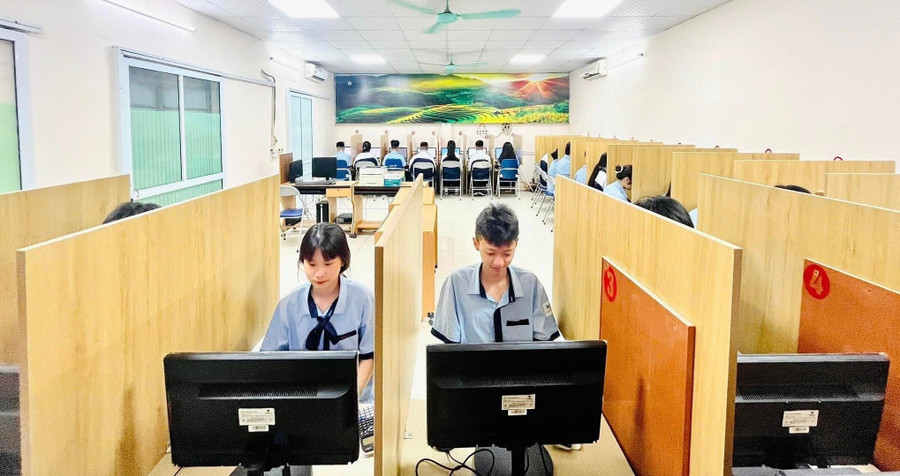
Broad-based assessments have been contributing to providing a comprehensive, periodic picture of student learning outcomes at specific levels and fields, thereby helping to accurately “identify” the educational reality of the country. The important, practical benefits of broad-based assessments go beyond just a regular test, specifically:
Schools and teachers receive quality feedback to improve teaching, learning, assessment and human resource and physical facilities conditions for implementing general education programs. The results of the large-scale assessment help the Ministry of Education and Training, Departments of Education and Training, and schools more clearly identify strengths and weaknesses in teaching and learning; the level of students achieving core competencies compared to the national average, thereby ensuring quality according to national standards, promoting outstanding points and regional and school diversity.
The staff and teachers participated in training sessions on techniques, expertise, methods, and assessment tools according to international standards to apply to assessing students' learning outcomes according to the competency and quality approach of the 2018 General Education Program.
Although the broad assessment is not intended to rank individuals, students still gain indirect experiences and benefits. They are exposed to tests that are designed to develop modern design competencies, often focusing on the application of knowledge and skills to solve practical problems, rather than just testing memorization.
Students are allowed to participate in a survey with a serious, synchronous, professional process nationwide, which may include a computer-based format. In particular, 11th grade students are allowed to participate in a survey with 3 key subjects (Math, Literature, English) on computers, approaching and preparing mentally when the High School Graduation Exam is implemented on computers.
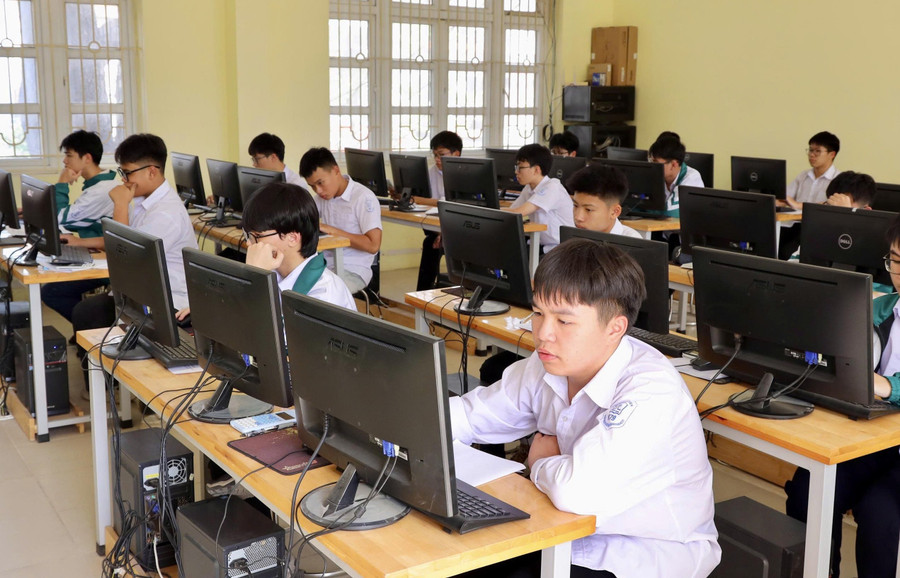
Different in nature from the High School Graduation Exam
- In your opinion, is there a need for more large-scale assessments when there is already a national high school graduation exam, which also provides data to assess the average level of high school students nationwide?
- Although both aim at the quality, efficiency and development of Vietnamese education, the High School Graduation Exam and the large-scale assessments have different purposes, so the requirements, scope and nature are completely different. The High School Graduation Exam has the results of individual assessment of each 12th grade student and equivalent (to see if the student is qualified to graduate, what is the score for university admission?). Large-scale assessment is to diagnose the system (where is the quality of education in a province or region, which subjects are students weak in at each level?).
To make it easier to understand, the High School Graduation Exam is like a doctor examining a specific person's health to conclude whether that person is healthy (can graduate or not) and prescribe medicine (to consider admission to a suitable university). Large-scale assessment is like an epidemiological agency researching public health, conducting a survey of a representative sample group to know the general health situation of the entire population (education system); from there, propose public health policies (educational reform, improving the quality of teaching and learning) for the entire community and suitable for target groups across the country.
- What do you think about the idea that the High School Graduation Exam can be combined with the large-scale assessment exam?
- One of the purposes of the High School Graduation Exam is to provide reliable and honest data that accurately assesses the abilities of 12th grade students so that universities and vocational training institutions can use it in enrollment in the spirit of autonomy. Therefore, the exam needs to be differentiated to classify candidates.
Meanwhile, large-scale assessment requires uniformity and stability in the survey/questionnaire system and organization over the years to compare and contrast quality trends over time. If combined, it is impossible to simultaneously differentiate candidates and have a stable measure to assess the entire system according to development stages.
In terms of target and scale, the high school graduation exam targets all 12th grade students with about one million candidates participating annually. Large-scale evaluation only needs to select a representative sample (according to scientific methods) to give reliable results enough to infer the quality of the whole system, a comprehensive survey is very expensive and unnecessary.
In terms of content, the high school graduation exam closely follows the requirements for grade 12 (and part of grade 10, 11) of the subjects students register for. The broad assessment focuses on assessing core competencies in areas such as Vietnamese/Literature, Mathematics, Science... corresponding to different levels and grades (grades 5, 9, 11...).
The optimal, appropriate solution is to recognize and respect differences in purpose; parties use data from exams and surveys intelligently.
Therefore, combining the High School Graduation Exam with the large-scale assessment is very difficult, even counterproductive because it does not meet the purpose and requirements of each activity for the development and effectiveness of the education system.
Thank you very much!
The goal of implementing a large-scale assessment of grades 5, 9, and 11 in the 2024-2027 period is to provide objective and reliable information on the quality of education for students in grades 5, 9, and 11, as a basis for proposing solutions and policies on innovation in teaching and learning activities to meet the requirements of implementing the current general education program, thereby improving the quality of general education and international integration.
Source: https://giaoducthoidai.vn/danh-gia-dien-rong-ket-qua-hoc-tap-cua-hs-buc-tranh-toan-dien-ve-hieu-qua-giao-duc-pho-thong-post756025.html




![[Photo] Unique architecture of the deepest metro station in France](https://vphoto.vietnam.vn/thumb/1200x675/vietnam/resource/IMAGE/2025/11/14/1763107592365_ga-sau-nhat-nuoc-phap-duy-1-6403-jpg.webp)
![[Photo] Unique art of painting Tuong masks](https://vphoto.vietnam.vn/thumb/1200x675/vietnam/resource/IMAGE/2025/11/14/1763094089301_ndo_br_1-jpg.webp)






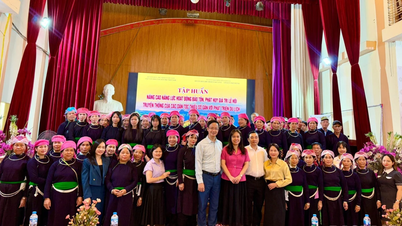


















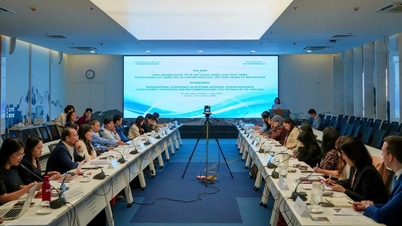




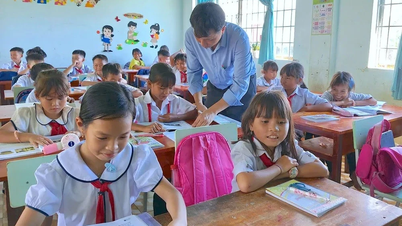

![[Photo] Special class in Tra Linh](https://vphoto.vietnam.vn/thumb/1200x675/vietnam/resource/IMAGE/2025/11/14/1763078485441_ndo_br_lop-hoc-7-jpg.webp)








































































Comment (0)